Business Operations and Organizational Structure: A Detailed Report
VerifiedAdded on 2021/02/22
|14
|4017
|46
Report
AI Summary
This report provides a comprehensive overview of business operations, examining various aspects of organizational structure, including franchise, sole trader, partnership, government, and charity models. It delves into the importance of PESTLE analysis, exploring political, economic, social, technological, legal, and environmental factors impacting businesses. The report further analyzes critical business functions such as accounting, HR functions (recruitment, payroll, employee relations, record keeping, and performance improvement), and employment legislation. It also includes an analysis of profit and loss accounts, team roles, team development stages, motivational theories, leadership styles, and the impact of customer service on business success. The report concludes by emphasizing the importance of accounting and customer profiling in achieving business objectives.
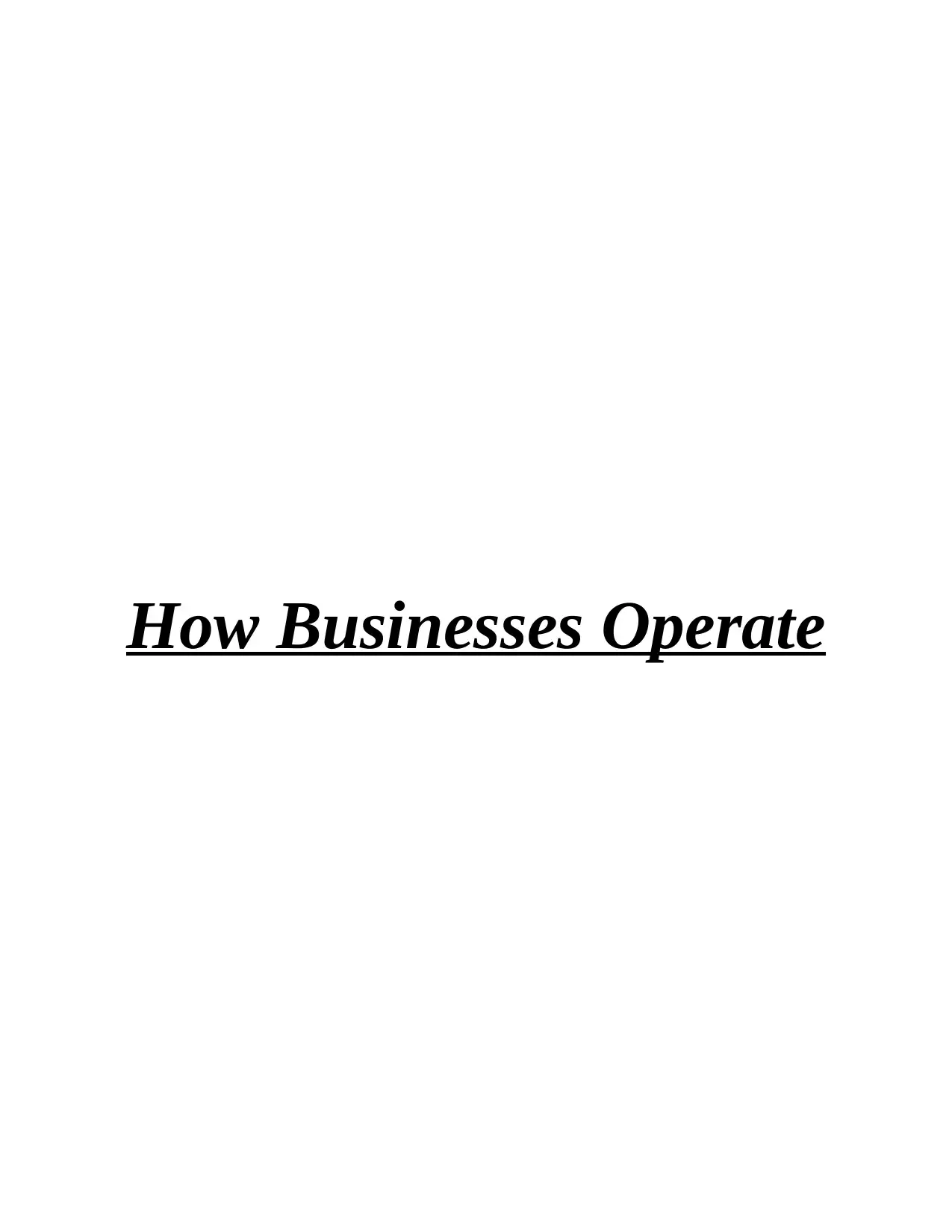
How Businesses Operate
Paraphrase This Document
Need a fresh take? Get an instant paraphrase of this document with our AI Paraphraser
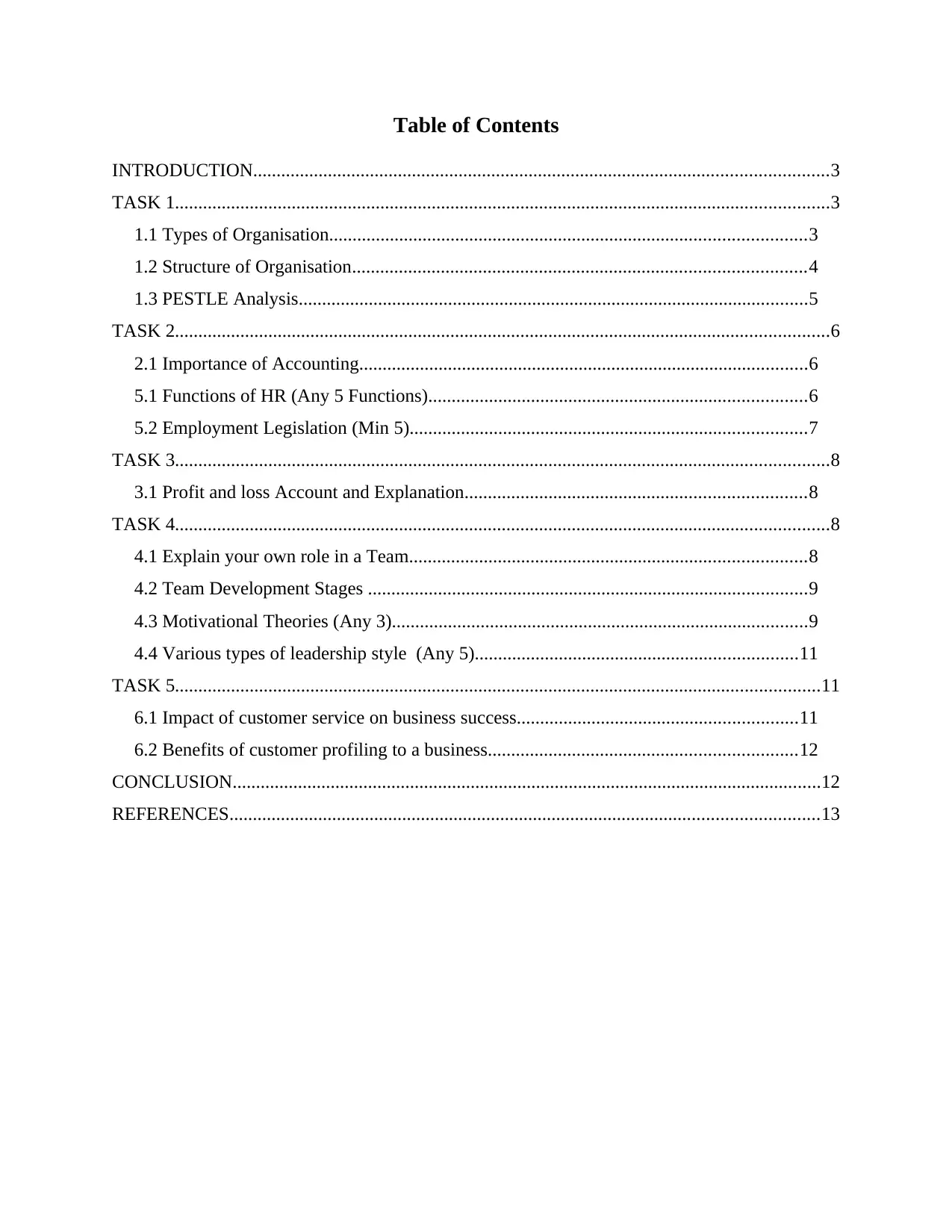
Table of Contents
INTRODUCTION...........................................................................................................................3
TASK 1............................................................................................................................................3
1.1 Types of Organisation......................................................................................................3
1.2 Structure of Organisation.................................................................................................4
1.3 PESTLE Analysis.............................................................................................................5
TASK 2............................................................................................................................................6
2.1 Importance of Accounting................................................................................................6
5.1 Functions of HR (Any 5 Functions).................................................................................6
5.2 Employment Legislation (Min 5).....................................................................................7
TASK 3............................................................................................................................................8
3.1 Profit and loss Account and Explanation.........................................................................8
TASK 4............................................................................................................................................8
4.1 Explain your own role in a Team.....................................................................................8
4.2 Team Development Stages ..............................................................................................9
4.3 Motivational Theories (Any 3).........................................................................................9
4.4 Various types of leadership style (Any 5).....................................................................11
TASK 5..........................................................................................................................................11
6.1 Impact of customer service on business success............................................................11
6.2 Benefits of customer profiling to a business..................................................................12
CONCLUSION..............................................................................................................................12
REFERENCES..............................................................................................................................13
INTRODUCTION...........................................................................................................................3
TASK 1............................................................................................................................................3
1.1 Types of Organisation......................................................................................................3
1.2 Structure of Organisation.................................................................................................4
1.3 PESTLE Analysis.............................................................................................................5
TASK 2............................................................................................................................................6
2.1 Importance of Accounting................................................................................................6
5.1 Functions of HR (Any 5 Functions).................................................................................6
5.2 Employment Legislation (Min 5).....................................................................................7
TASK 3............................................................................................................................................8
3.1 Profit and loss Account and Explanation.........................................................................8
TASK 4............................................................................................................................................8
4.1 Explain your own role in a Team.....................................................................................8
4.2 Team Development Stages ..............................................................................................9
4.3 Motivational Theories (Any 3).........................................................................................9
4.4 Various types of leadership style (Any 5).....................................................................11
TASK 5..........................................................................................................................................11
6.1 Impact of customer service on business success............................................................11
6.2 Benefits of customer profiling to a business..................................................................12
CONCLUSION..............................................................................................................................12
REFERENCES..............................................................................................................................13
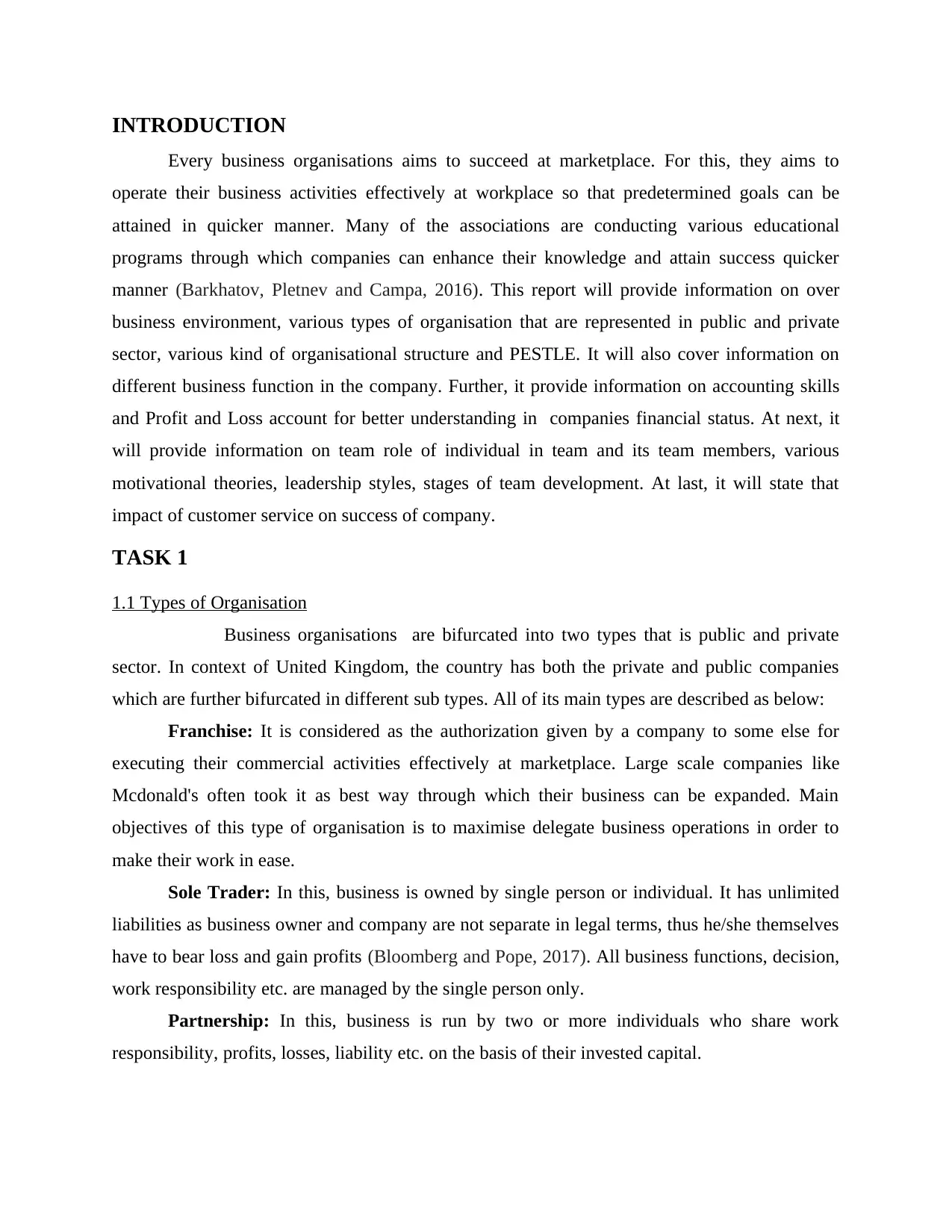
INTRODUCTION
Every business organisations aims to succeed at marketplace. For this, they aims to
operate their business activities effectively at workplace so that predetermined goals can be
attained in quicker manner. Many of the associations are conducting various educational
programs through which companies can enhance their knowledge and attain success quicker
manner (Barkhatov, Pletnev and Campa, 2016). This report will provide information on over
business environment, various types of organisation that are represented in public and private
sector, various kind of organisational structure and PESTLE. It will also cover information on
different business function in the company. Further, it provide information on accounting skills
and Profit and Loss account for better understanding in companies financial status. At next, it
will provide information on team role of individual in team and its team members, various
motivational theories, leadership styles, stages of team development. At last, it will state that
impact of customer service on success of company.
TASK 1
1.1 Types of Organisation
Business organisations are bifurcated into two types that is public and private
sector. In context of United Kingdom, the country has both the private and public companies
which are further bifurcated in different sub types. All of its main types are described as below:
Franchise: It is considered as the authorization given by a company to some else for
executing their commercial activities effectively at marketplace. Large scale companies like
Mcdonald's often took it as best way through which their business can be expanded. Main
objectives of this type of organisation is to maximise delegate business operations in order to
make their work in ease.
Sole Trader: In this, business is owned by single person or individual. It has unlimited
liabilities as business owner and company are not separate in legal terms, thus he/she themselves
have to bear loss and gain profits (Bloomberg and Pope, 2017). All business functions, decision,
work responsibility etc. are managed by the single person only.
Partnership: In this, business is run by two or more individuals who share work
responsibility, profits, losses, liability etc. on the basis of their invested capital.
Every business organisations aims to succeed at marketplace. For this, they aims to
operate their business activities effectively at workplace so that predetermined goals can be
attained in quicker manner. Many of the associations are conducting various educational
programs through which companies can enhance their knowledge and attain success quicker
manner (Barkhatov, Pletnev and Campa, 2016). This report will provide information on over
business environment, various types of organisation that are represented in public and private
sector, various kind of organisational structure and PESTLE. It will also cover information on
different business function in the company. Further, it provide information on accounting skills
and Profit and Loss account for better understanding in companies financial status. At next, it
will provide information on team role of individual in team and its team members, various
motivational theories, leadership styles, stages of team development. At last, it will state that
impact of customer service on success of company.
TASK 1
1.1 Types of Organisation
Business organisations are bifurcated into two types that is public and private
sector. In context of United Kingdom, the country has both the private and public companies
which are further bifurcated in different sub types. All of its main types are described as below:
Franchise: It is considered as the authorization given by a company to some else for
executing their commercial activities effectively at marketplace. Large scale companies like
Mcdonald's often took it as best way through which their business can be expanded. Main
objectives of this type of organisation is to maximise delegate business operations in order to
make their work in ease.
Sole Trader: In this, business is owned by single person or individual. It has unlimited
liabilities as business owner and company are not separate in legal terms, thus he/she themselves
have to bear loss and gain profits (Bloomberg and Pope, 2017). All business functions, decision,
work responsibility etc. are managed by the single person only.
Partnership: In this, business is run by two or more individuals who share work
responsibility, profits, losses, liability etc. on the basis of their invested capital.
⊘ This is a preview!⊘
Do you want full access?
Subscribe today to unlock all pages.

Trusted by 1+ million students worldwide
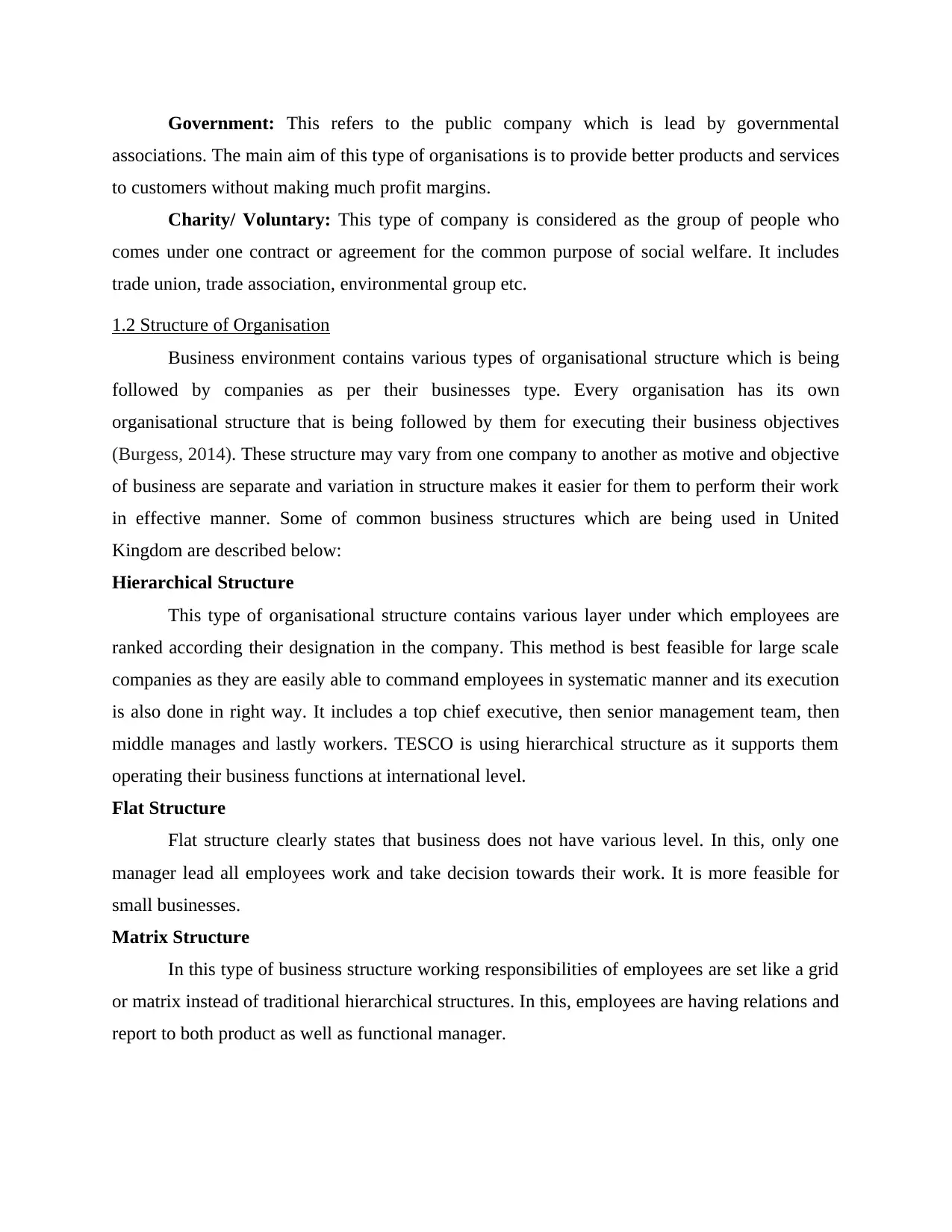
Government: This refers to the public company which is lead by governmental
associations. The main aim of this type of organisations is to provide better products and services
to customers without making much profit margins.
Charity/ Voluntary: This type of company is considered as the group of people who
comes under one contract or agreement for the common purpose of social welfare. It includes
trade union, trade association, environmental group etc.
1.2 Structure of Organisation
Business environment contains various types of organisational structure which is being
followed by companies as per their businesses type. Every organisation has its own
organisational structure that is being followed by them for executing their business objectives
(Burgess, 2014). These structure may vary from one company to another as motive and objective
of business are separate and variation in structure makes it easier for them to perform their work
in effective manner. Some of common business structures which are being used in United
Kingdom are described below:
Hierarchical Structure
This type of organisational structure contains various layer under which employees are
ranked according their designation in the company. This method is best feasible for large scale
companies as they are easily able to command employees in systematic manner and its execution
is also done in right way. It includes a top chief executive, then senior management team, then
middle manages and lastly workers. TESCO is using hierarchical structure as it supports them
operating their business functions at international level.
Flat Structure
Flat structure clearly states that business does not have various level. In this, only one
manager lead all employees work and take decision towards their work. It is more feasible for
small businesses.
Matrix Structure
In this type of business structure working responsibilities of employees are set like a grid
or matrix instead of traditional hierarchical structures. In this, employees are having relations and
report to both product as well as functional manager.
associations. The main aim of this type of organisations is to provide better products and services
to customers without making much profit margins.
Charity/ Voluntary: This type of company is considered as the group of people who
comes under one contract or agreement for the common purpose of social welfare. It includes
trade union, trade association, environmental group etc.
1.2 Structure of Organisation
Business environment contains various types of organisational structure which is being
followed by companies as per their businesses type. Every organisation has its own
organisational structure that is being followed by them for executing their business objectives
(Burgess, 2014). These structure may vary from one company to another as motive and objective
of business are separate and variation in structure makes it easier for them to perform their work
in effective manner. Some of common business structures which are being used in United
Kingdom are described below:
Hierarchical Structure
This type of organisational structure contains various layer under which employees are
ranked according their designation in the company. This method is best feasible for large scale
companies as they are easily able to command employees in systematic manner and its execution
is also done in right way. It includes a top chief executive, then senior management team, then
middle manages and lastly workers. TESCO is using hierarchical structure as it supports them
operating their business functions at international level.
Flat Structure
Flat structure clearly states that business does not have various level. In this, only one
manager lead all employees work and take decision towards their work. It is more feasible for
small businesses.
Matrix Structure
In this type of business structure working responsibilities of employees are set like a grid
or matrix instead of traditional hierarchical structures. In this, employees are having relations and
report to both product as well as functional manager.
Paraphrase This Document
Need a fresh take? Get an instant paraphrase of this document with our AI Paraphraser
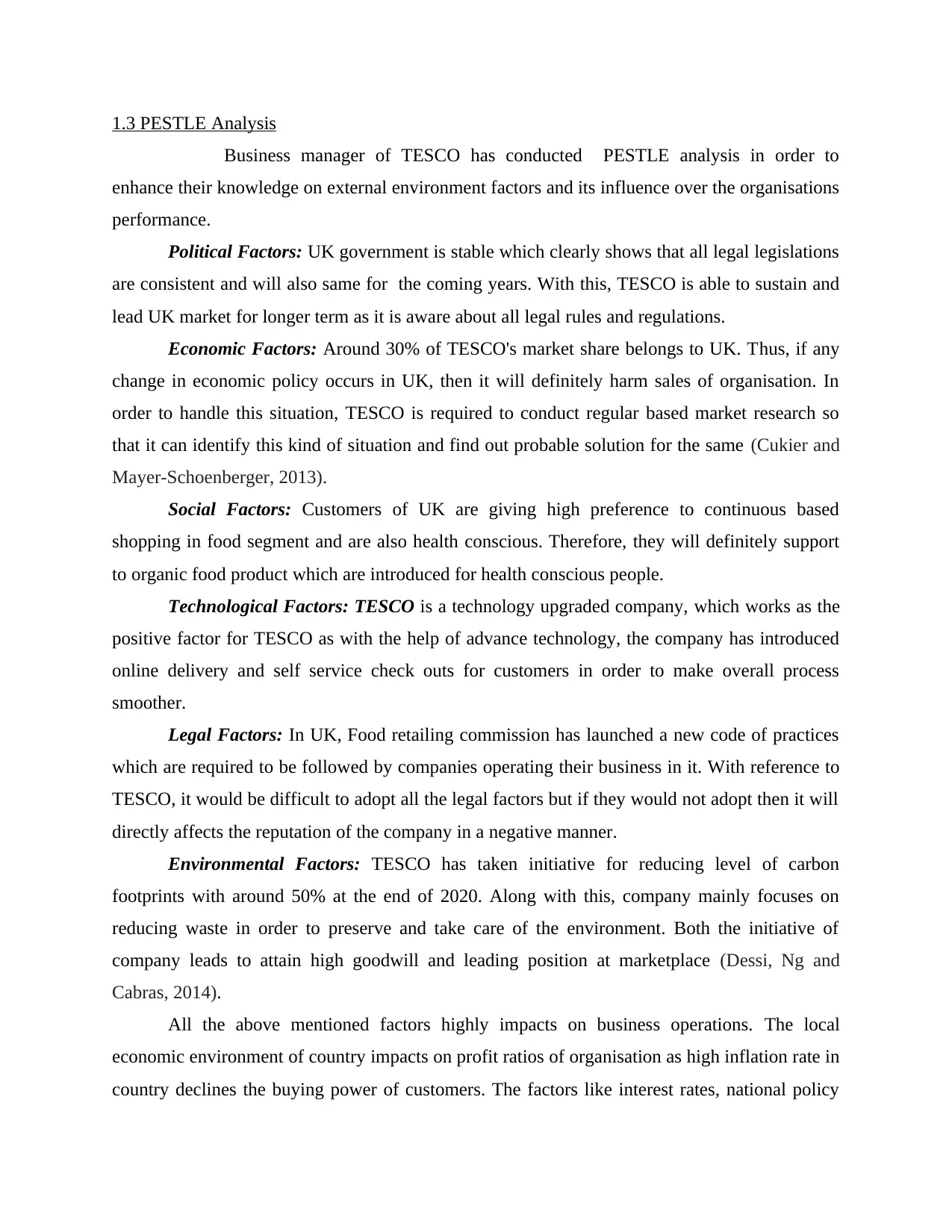
1.3 PESTLE Analysis
Business manager of TESCO has conducted PESTLE analysis in order to
enhance their knowledge on external environment factors and its influence over the organisations
performance.
Political Factors: UK government is stable which clearly shows that all legal legislations
are consistent and will also same for the coming years. With this, TESCO is able to sustain and
lead UK market for longer term as it is aware about all legal rules and regulations.
Economic Factors: Around 30% of TESCO's market share belongs to UK. Thus, if any
change in economic policy occurs in UK, then it will definitely harm sales of organisation. In
order to handle this situation, TESCO is required to conduct regular based market research so
that it can identify this kind of situation and find out probable solution for the same (Cukier and
Mayer-Schoenberger, 2013).
Social Factors: Customers of UK are giving high preference to continuous based
shopping in food segment and are also health conscious. Therefore, they will definitely support
to organic food product which are introduced for health conscious people.
Technological Factors: TESCO is a technology upgraded company, which works as the
positive factor for TESCO as with the help of advance technology, the company has introduced
online delivery and self service check outs for customers in order to make overall process
smoother.
Legal Factors: In UK, Food retailing commission has launched a new code of practices
which are required to be followed by companies operating their business in it. With reference to
TESCO, it would be difficult to adopt all the legal factors but if they would not adopt then it will
directly affects the reputation of the company in a negative manner.
Environmental Factors: TESCO has taken initiative for reducing level of carbon
footprints with around 50% at the end of 2020. Along with this, company mainly focuses on
reducing waste in order to preserve and take care of the environment. Both the initiative of
company leads to attain high goodwill and leading position at marketplace (Dessi, Ng and
Cabras, 2014).
All the above mentioned factors highly impacts on business operations. The local
economic environment of country impacts on profit ratios of organisation as high inflation rate in
country declines the buying power of customers. The factors like interest rates, national policy
Business manager of TESCO has conducted PESTLE analysis in order to
enhance their knowledge on external environment factors and its influence over the organisations
performance.
Political Factors: UK government is stable which clearly shows that all legal legislations
are consistent and will also same for the coming years. With this, TESCO is able to sustain and
lead UK market for longer term as it is aware about all legal rules and regulations.
Economic Factors: Around 30% of TESCO's market share belongs to UK. Thus, if any
change in economic policy occurs in UK, then it will definitely harm sales of organisation. In
order to handle this situation, TESCO is required to conduct regular based market research so
that it can identify this kind of situation and find out probable solution for the same (Cukier and
Mayer-Schoenberger, 2013).
Social Factors: Customers of UK are giving high preference to continuous based
shopping in food segment and are also health conscious. Therefore, they will definitely support
to organic food product which are introduced for health conscious people.
Technological Factors: TESCO is a technology upgraded company, which works as the
positive factor for TESCO as with the help of advance technology, the company has introduced
online delivery and self service check outs for customers in order to make overall process
smoother.
Legal Factors: In UK, Food retailing commission has launched a new code of practices
which are required to be followed by companies operating their business in it. With reference to
TESCO, it would be difficult to adopt all the legal factors but if they would not adopt then it will
directly affects the reputation of the company in a negative manner.
Environmental Factors: TESCO has taken initiative for reducing level of carbon
footprints with around 50% at the end of 2020. Along with this, company mainly focuses on
reducing waste in order to preserve and take care of the environment. Both the initiative of
company leads to attain high goodwill and leading position at marketplace (Dessi, Ng and
Cabras, 2014).
All the above mentioned factors highly impacts on business operations. The local
economic environment of country impacts on profit ratios of organisation as high inflation rate in
country declines the buying power of customers. The factors like interest rates, national policy
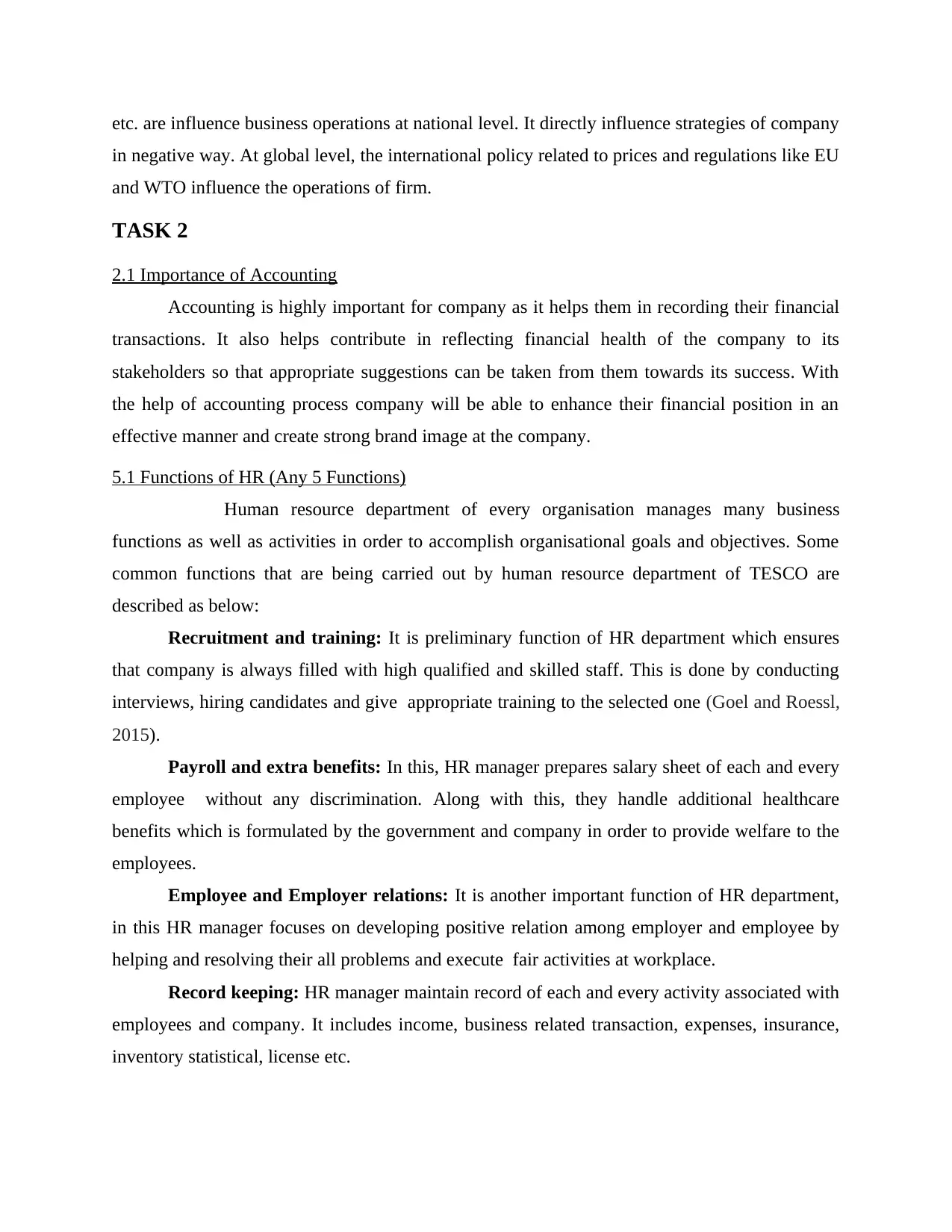
etc. are influence business operations at national level. It directly influence strategies of company
in negative way. At global level, the international policy related to prices and regulations like EU
and WTO influence the operations of firm.
TASK 2
2.1 Importance of Accounting
Accounting is highly important for company as it helps them in recording their financial
transactions. It also helps contribute in reflecting financial health of the company to its
stakeholders so that appropriate suggestions can be taken from them towards its success. With
the help of accounting process company will be able to enhance their financial position in an
effective manner and create strong brand image at the company.
5.1 Functions of HR (Any 5 Functions)
Human resource department of every organisation manages many business
functions as well as activities in order to accomplish organisational goals and objectives. Some
common functions that are being carried out by human resource department of TESCO are
described as below:
Recruitment and training: It is preliminary function of HR department which ensures
that company is always filled with high qualified and skilled staff. This is done by conducting
interviews, hiring candidates and give appropriate training to the selected one (Goel and Roessl,
2015).
Payroll and extra benefits: In this, HR manager prepares salary sheet of each and every
employee without any discrimination. Along with this, they handle additional healthcare
benefits which is formulated by the government and company in order to provide welfare to the
employees.
Employee and Employer relations: It is another important function of HR department,
in this HR manager focuses on developing positive relation among employer and employee by
helping and resolving their all problems and execute fair activities at workplace.
Record keeping: HR manager maintain record of each and every activity associated with
employees and company. It includes income, business related transaction, expenses, insurance,
inventory statistical, license etc.
in negative way. At global level, the international policy related to prices and regulations like EU
and WTO influence the operations of firm.
TASK 2
2.1 Importance of Accounting
Accounting is highly important for company as it helps them in recording their financial
transactions. It also helps contribute in reflecting financial health of the company to its
stakeholders so that appropriate suggestions can be taken from them towards its success. With
the help of accounting process company will be able to enhance their financial position in an
effective manner and create strong brand image at the company.
5.1 Functions of HR (Any 5 Functions)
Human resource department of every organisation manages many business
functions as well as activities in order to accomplish organisational goals and objectives. Some
common functions that are being carried out by human resource department of TESCO are
described as below:
Recruitment and training: It is preliminary function of HR department which ensures
that company is always filled with high qualified and skilled staff. This is done by conducting
interviews, hiring candidates and give appropriate training to the selected one (Goel and Roessl,
2015).
Payroll and extra benefits: In this, HR manager prepares salary sheet of each and every
employee without any discrimination. Along with this, they handle additional healthcare
benefits which is formulated by the government and company in order to provide welfare to the
employees.
Employee and Employer relations: It is another important function of HR department,
in this HR manager focuses on developing positive relation among employer and employee by
helping and resolving their all problems and execute fair activities at workplace.
Record keeping: HR manager maintain record of each and every activity associated with
employees and company. It includes income, business related transaction, expenses, insurance,
inventory statistical, license etc.
⊘ This is a preview!⊘
Do you want full access?
Subscribe today to unlock all pages.

Trusted by 1+ million students worldwide
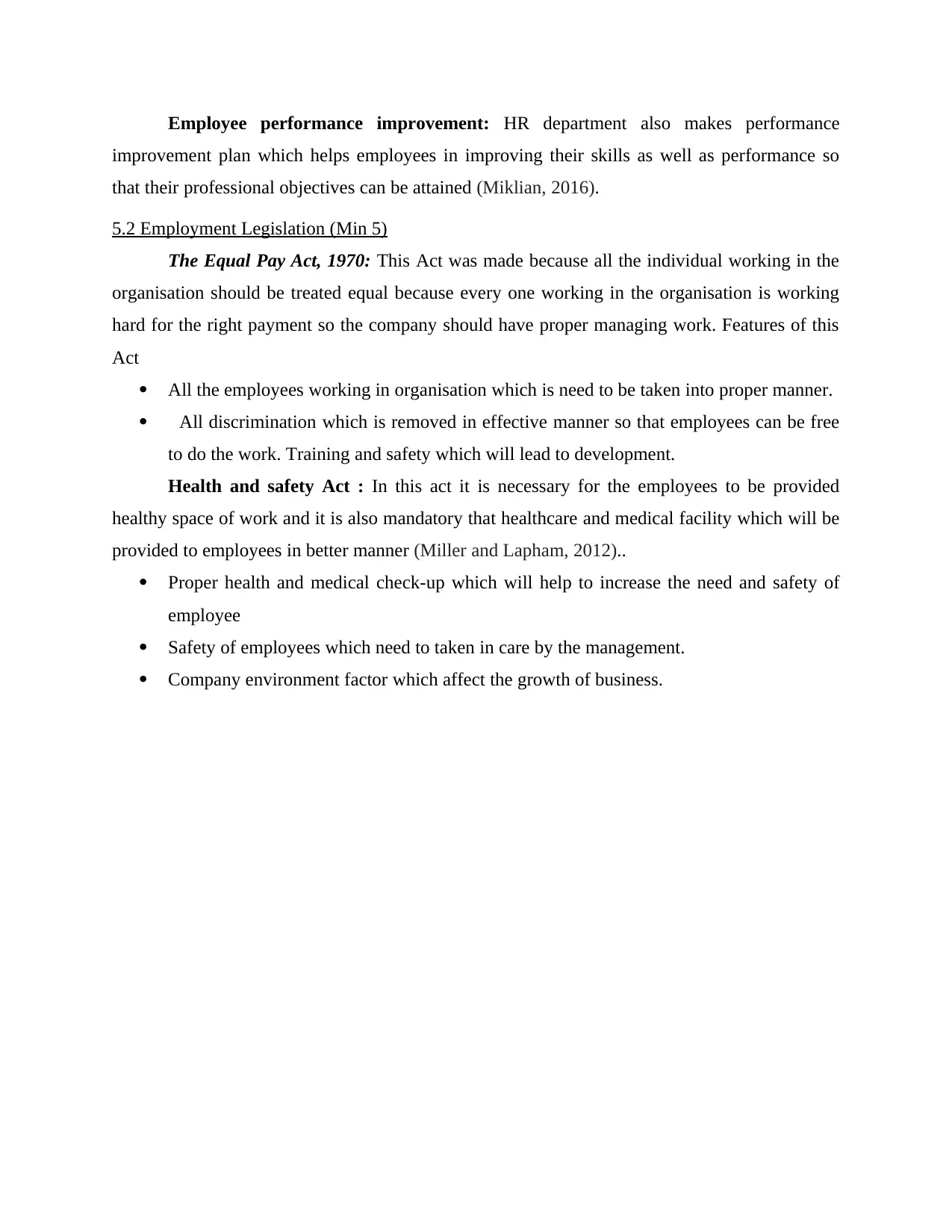
Employee performance improvement: HR department also makes performance
improvement plan which helps employees in improving their skills as well as performance so
that their professional objectives can be attained (Miklian, 2016).
5.2 Employment Legislation (Min 5)
The Equal Pay Act, 1970: This Act was made because all the individual working in the
organisation should be treated equal because every one working in the organisation is working
hard for the right payment so the company should have proper managing work. Features of this
Act
All the employees working in organisation which is need to be taken into proper manner.
All discrimination which is removed in effective manner so that employees can be free
to do the work. Training and safety which will lead to development.
Health and safety Act : In this act it is necessary for the employees to be provided
healthy space of work and it is also mandatory that healthcare and medical facility which will be
provided to employees in better manner (Miller and Lapham, 2012)..
Proper health and medical check-up which will help to increase the need and safety of
employee
Safety of employees which need to taken in care by the management.
Company environment factor which affect the growth of business.
improvement plan which helps employees in improving their skills as well as performance so
that their professional objectives can be attained (Miklian, 2016).
5.2 Employment Legislation (Min 5)
The Equal Pay Act, 1970: This Act was made because all the individual working in the
organisation should be treated equal because every one working in the organisation is working
hard for the right payment so the company should have proper managing work. Features of this
Act
All the employees working in organisation which is need to be taken into proper manner.
All discrimination which is removed in effective manner so that employees can be free
to do the work. Training and safety which will lead to development.
Health and safety Act : In this act it is necessary for the employees to be provided
healthy space of work and it is also mandatory that healthcare and medical facility which will be
provided to employees in better manner (Miller and Lapham, 2012)..
Proper health and medical check-up which will help to increase the need and safety of
employee
Safety of employees which need to taken in care by the management.
Company environment factor which affect the growth of business.
Paraphrase This Document
Need a fresh take? Get an instant paraphrase of this document with our AI Paraphraser
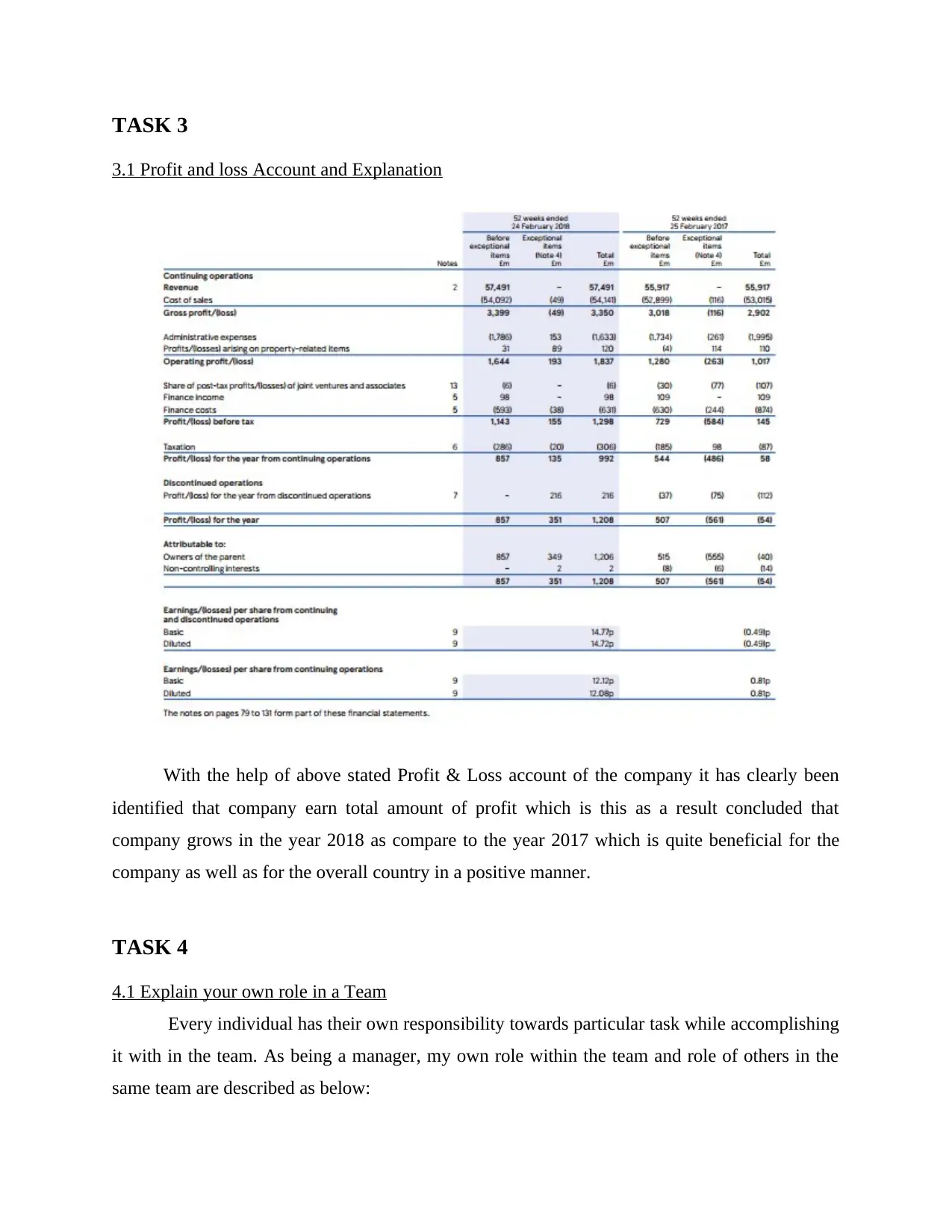
TASK 3
3.1 Profit and loss Account and Explanation
With the help of above stated Profit & Loss account of the company it has clearly been
identified that company earn total amount of profit which is this as a result concluded that
company grows in the year 2018 as compare to the year 2017 which is quite beneficial for the
company as well as for the overall country in a positive manner.
TASK 4
4.1 Explain your own role in a Team
Every individual has their own responsibility towards particular task while accomplishing
it with in the team. As being a manager, my own role within the team and role of others in the
same team are described as below:
3.1 Profit and loss Account and Explanation
With the help of above stated Profit & Loss account of the company it has clearly been
identified that company earn total amount of profit which is this as a result concluded that
company grows in the year 2018 as compare to the year 2017 which is quite beneficial for the
company as well as for the overall country in a positive manner.
TASK 4
4.1 Explain your own role in a Team
Every individual has their own responsibility towards particular task while accomplishing
it with in the team. As being a manager, my own role within the team and role of others in the
same team are described as below:
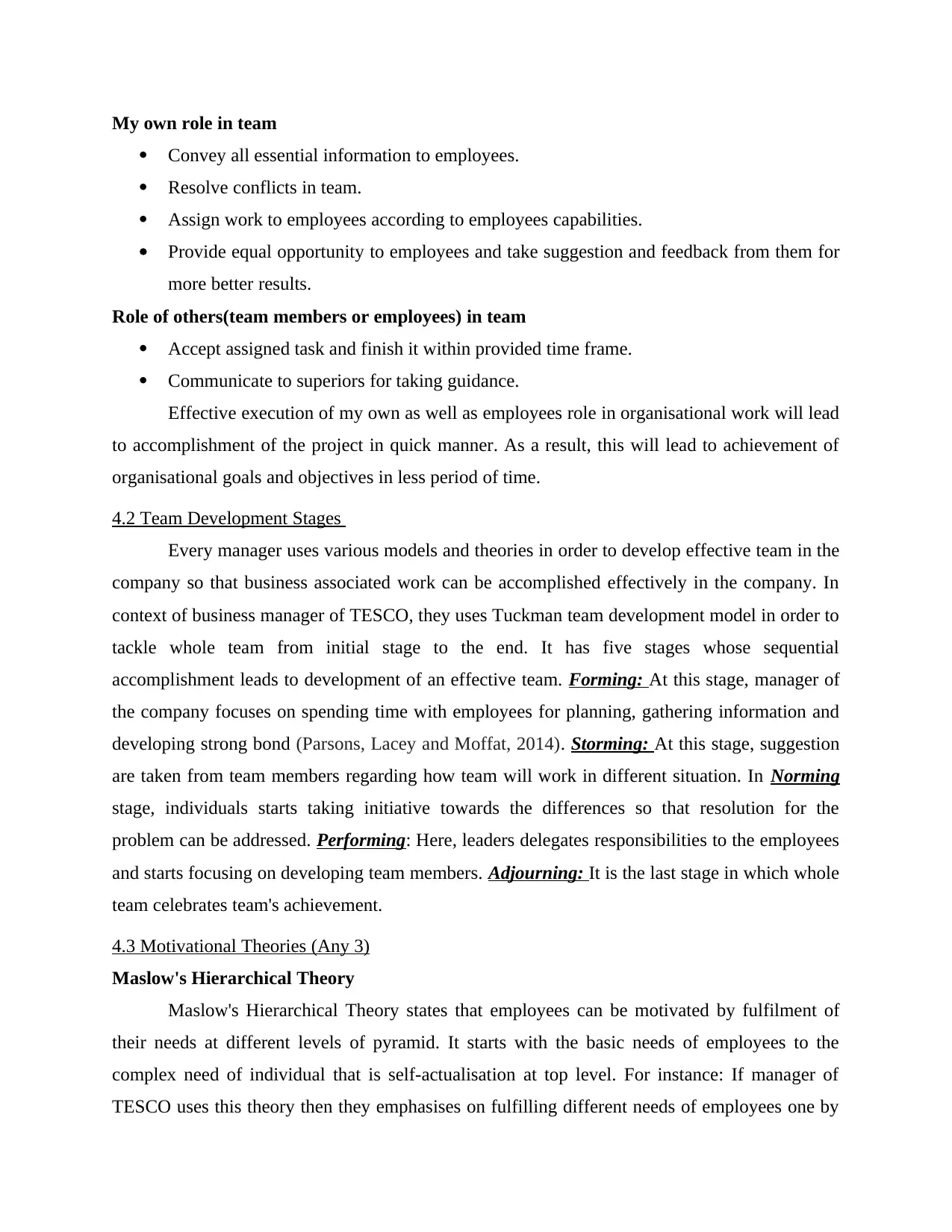
My own role in team
Convey all essential information to employees.
Resolve conflicts in team.
Assign work to employees according to employees capabilities.
Provide equal opportunity to employees and take suggestion and feedback from them for
more better results.
Role of others(team members or employees) in team
Accept assigned task and finish it within provided time frame.
Communicate to superiors for taking guidance.
Effective execution of my own as well as employees role in organisational work will lead
to accomplishment of the project in quick manner. As a result, this will lead to achievement of
organisational goals and objectives in less period of time.
4.2 Team Development Stages
Every manager uses various models and theories in order to develop effective team in the
company so that business associated work can be accomplished effectively in the company. In
context of business manager of TESCO, they uses Tuckman team development model in order to
tackle whole team from initial stage to the end. It has five stages whose sequential
accomplishment leads to development of an effective team. Forming: At this stage, manager of
the company focuses on spending time with employees for planning, gathering information and
developing strong bond (Parsons, Lacey and Moffat, 2014). Storming: At this stage, suggestion
are taken from team members regarding how team will work in different situation. In Norming
stage, individuals starts taking initiative towards the differences so that resolution for the
problem can be addressed. Performing: Here, leaders delegates responsibilities to the employees
and starts focusing on developing team members. Adjourning: It is the last stage in which whole
team celebrates team's achievement.
4.3 Motivational Theories (Any 3)
Maslow's Hierarchical Theory
Maslow's Hierarchical Theory states that employees can be motivated by fulfilment of
their needs at different levels of pyramid. It starts with the basic needs of employees to the
complex need of individual that is self-actualisation at top level. For instance: If manager of
TESCO uses this theory then they emphasises on fulfilling different needs of employees one by
Convey all essential information to employees.
Resolve conflicts in team.
Assign work to employees according to employees capabilities.
Provide equal opportunity to employees and take suggestion and feedback from them for
more better results.
Role of others(team members or employees) in team
Accept assigned task and finish it within provided time frame.
Communicate to superiors for taking guidance.
Effective execution of my own as well as employees role in organisational work will lead
to accomplishment of the project in quick manner. As a result, this will lead to achievement of
organisational goals and objectives in less period of time.
4.2 Team Development Stages
Every manager uses various models and theories in order to develop effective team in the
company so that business associated work can be accomplished effectively in the company. In
context of business manager of TESCO, they uses Tuckman team development model in order to
tackle whole team from initial stage to the end. It has five stages whose sequential
accomplishment leads to development of an effective team. Forming: At this stage, manager of
the company focuses on spending time with employees for planning, gathering information and
developing strong bond (Parsons, Lacey and Moffat, 2014). Storming: At this stage, suggestion
are taken from team members regarding how team will work in different situation. In Norming
stage, individuals starts taking initiative towards the differences so that resolution for the
problem can be addressed. Performing: Here, leaders delegates responsibilities to the employees
and starts focusing on developing team members. Adjourning: It is the last stage in which whole
team celebrates team's achievement.
4.3 Motivational Theories (Any 3)
Maslow's Hierarchical Theory
Maslow's Hierarchical Theory states that employees can be motivated by fulfilment of
their needs at different levels of pyramid. It starts with the basic needs of employees to the
complex need of individual that is self-actualisation at top level. For instance: If manager of
TESCO uses this theory then they emphasises on fulfilling different needs of employees one by
⊘ This is a preview!⊘
Do you want full access?
Subscribe today to unlock all pages.

Trusted by 1+ million students worldwide
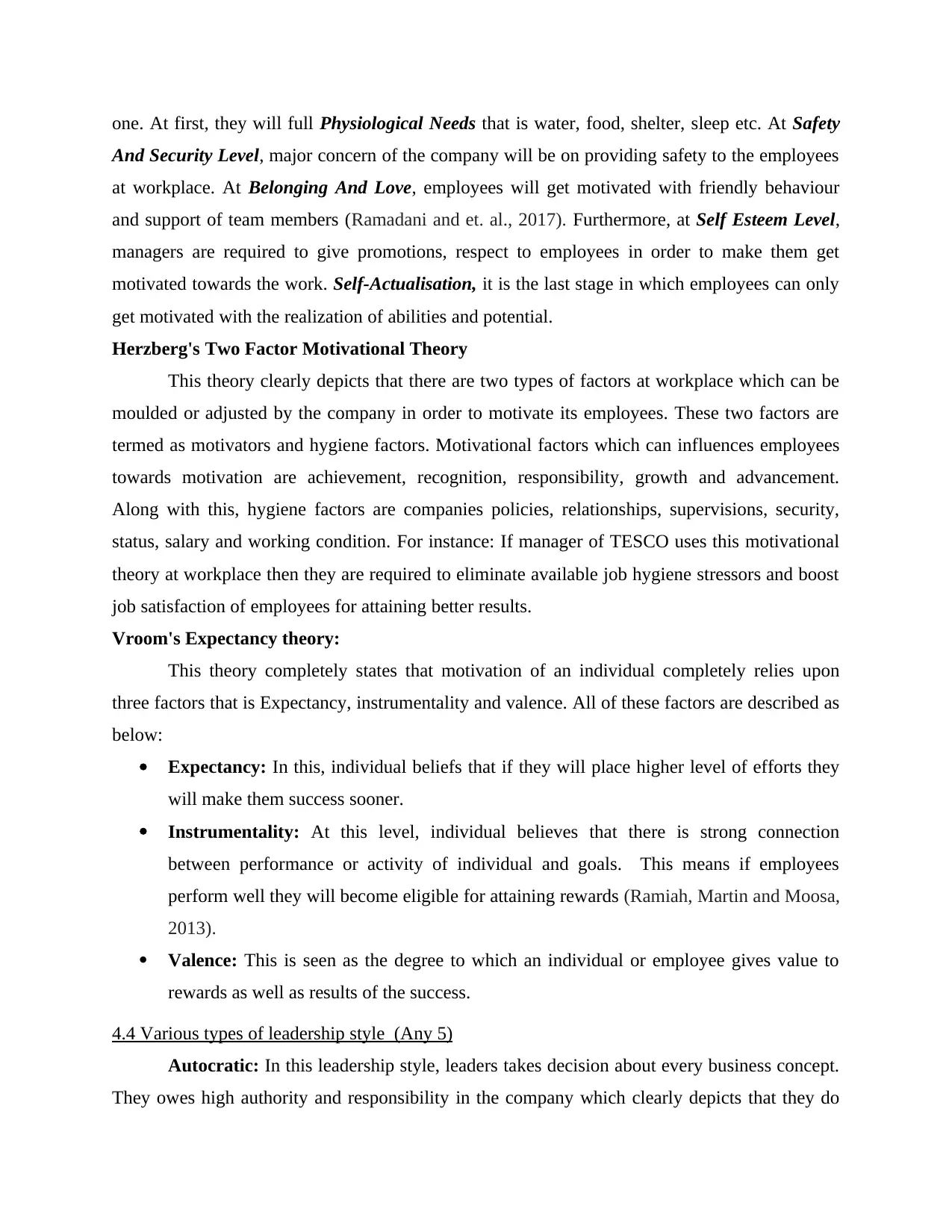
one. At first, they will full Physiological Needs that is water, food, shelter, sleep etc. At Safety
And Security Level, major concern of the company will be on providing safety to the employees
at workplace. At Belonging And Love, employees will get motivated with friendly behaviour
and support of team members (Ramadani and et. al., 2017). Furthermore, at Self Esteem Level,
managers are required to give promotions, respect to employees in order to make them get
motivated towards the work. Self-Actualisation, it is the last stage in which employees can only
get motivated with the realization of abilities and potential.
Herzberg's Two Factor Motivational Theory
This theory clearly depicts that there are two types of factors at workplace which can be
moulded or adjusted by the company in order to motivate its employees. These two factors are
termed as motivators and hygiene factors. Motivational factors which can influences employees
towards motivation are achievement, recognition, responsibility, growth and advancement.
Along with this, hygiene factors are companies policies, relationships, supervisions, security,
status, salary and working condition. For instance: If manager of TESCO uses this motivational
theory at workplace then they are required to eliminate available job hygiene stressors and boost
job satisfaction of employees for attaining better results.
Vroom's Expectancy theory:
This theory completely states that motivation of an individual completely relies upon
three factors that is Expectancy, instrumentality and valence. All of these factors are described as
below:
Expectancy: In this, individual beliefs that if they will place higher level of efforts they
will make them success sooner.
Instrumentality: At this level, individual believes that there is strong connection
between performance or activity of individual and goals. This means if employees
perform well they will become eligible for attaining rewards (Ramiah, Martin and Moosa,
2013).
Valence: This is seen as the degree to which an individual or employee gives value to
rewards as well as results of the success.
4.4 Various types of leadership style (Any 5)
Autocratic: In this leadership style, leaders takes decision about every business concept.
They owes high authority and responsibility in the company which clearly depicts that they do
And Security Level, major concern of the company will be on providing safety to the employees
at workplace. At Belonging And Love, employees will get motivated with friendly behaviour
and support of team members (Ramadani and et. al., 2017). Furthermore, at Self Esteem Level,
managers are required to give promotions, respect to employees in order to make them get
motivated towards the work. Self-Actualisation, it is the last stage in which employees can only
get motivated with the realization of abilities and potential.
Herzberg's Two Factor Motivational Theory
This theory clearly depicts that there are two types of factors at workplace which can be
moulded or adjusted by the company in order to motivate its employees. These two factors are
termed as motivators and hygiene factors. Motivational factors which can influences employees
towards motivation are achievement, recognition, responsibility, growth and advancement.
Along with this, hygiene factors are companies policies, relationships, supervisions, security,
status, salary and working condition. For instance: If manager of TESCO uses this motivational
theory at workplace then they are required to eliminate available job hygiene stressors and boost
job satisfaction of employees for attaining better results.
Vroom's Expectancy theory:
This theory completely states that motivation of an individual completely relies upon
three factors that is Expectancy, instrumentality and valence. All of these factors are described as
below:
Expectancy: In this, individual beliefs that if they will place higher level of efforts they
will make them success sooner.
Instrumentality: At this level, individual believes that there is strong connection
between performance or activity of individual and goals. This means if employees
perform well they will become eligible for attaining rewards (Ramiah, Martin and Moosa,
2013).
Valence: This is seen as the degree to which an individual or employee gives value to
rewards as well as results of the success.
4.4 Various types of leadership style (Any 5)
Autocratic: In this leadership style, leaders takes decision about every business concept.
They owes high authority and responsibility in the company which clearly depicts that they do
Paraphrase This Document
Need a fresh take? Get an instant paraphrase of this document with our AI Paraphraser
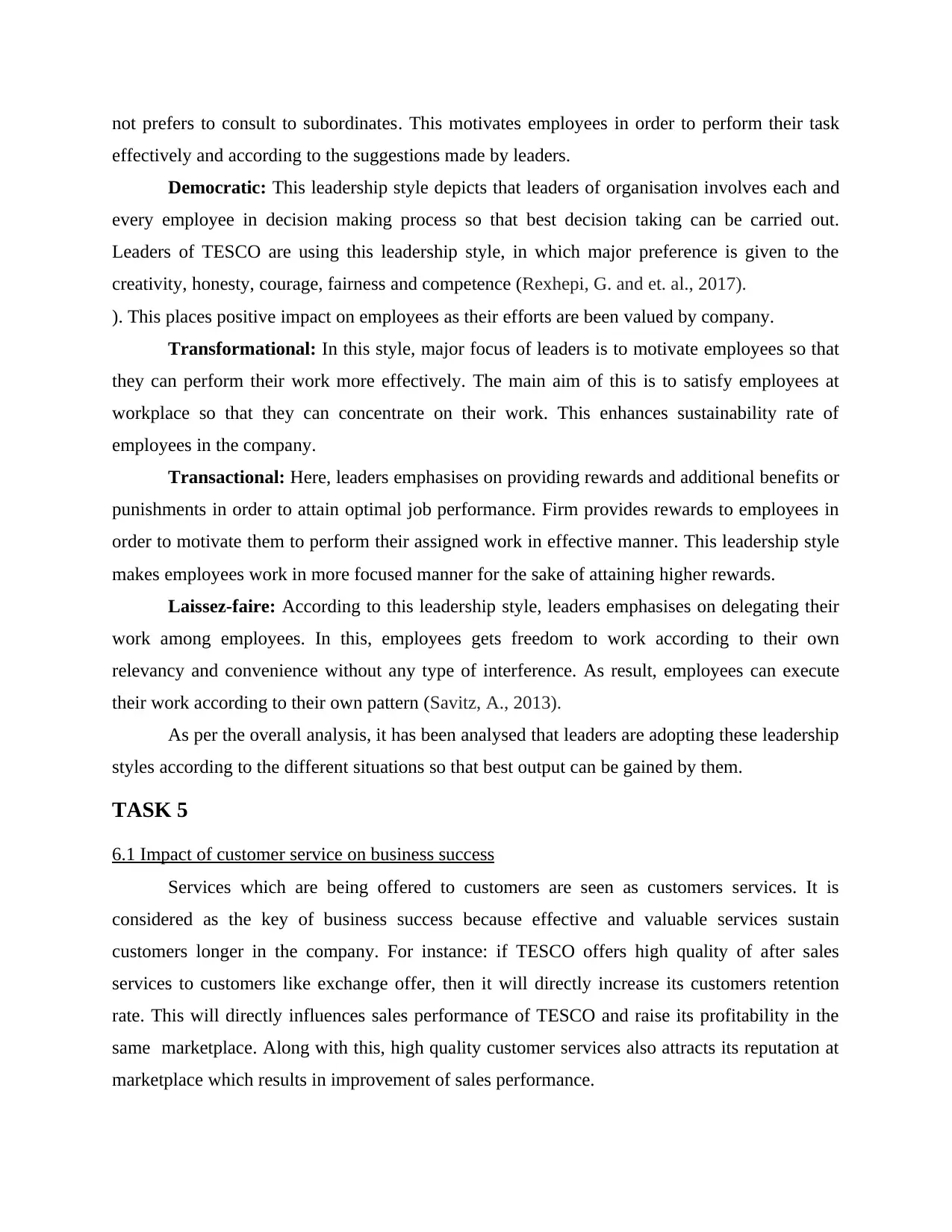
not prefers to consult to subordinates. This motivates employees in order to perform their task
effectively and according to the suggestions made by leaders.
Democratic: This leadership style depicts that leaders of organisation involves each and
every employee in decision making process so that best decision taking can be carried out.
Leaders of TESCO are using this leadership style, in which major preference is given to the
creativity, honesty, courage, fairness and competence (Rexhepi, G. and et. al., 2017).
). This places positive impact on employees as their efforts are been valued by company.
Transformational: In this style, major focus of leaders is to motivate employees so that
they can perform their work more effectively. The main aim of this is to satisfy employees at
workplace so that they can concentrate on their work. This enhances sustainability rate of
employees in the company.
Transactional: Here, leaders emphasises on providing rewards and additional benefits or
punishments in order to attain optimal job performance. Firm provides rewards to employees in
order to motivate them to perform their assigned work in effective manner. This leadership style
makes employees work in more focused manner for the sake of attaining higher rewards.
Laissez-faire: According to this leadership style, leaders emphasises on delegating their
work among employees. In this, employees gets freedom to work according to their own
relevancy and convenience without any type of interference. As result, employees can execute
their work according to their own pattern (Savitz, A., 2013).
As per the overall analysis, it has been analysed that leaders are adopting these leadership
styles according to the different situations so that best output can be gained by them.
TASK 5
6.1 Impact of customer service on business success
Services which are being offered to customers are seen as customers services. It is
considered as the key of business success because effective and valuable services sustain
customers longer in the company. For instance: if TESCO offers high quality of after sales
services to customers like exchange offer, then it will directly increase its customers retention
rate. This will directly influences sales performance of TESCO and raise its profitability in the
same marketplace. Along with this, high quality customer services also attracts its reputation at
marketplace which results in improvement of sales performance.
effectively and according to the suggestions made by leaders.
Democratic: This leadership style depicts that leaders of organisation involves each and
every employee in decision making process so that best decision taking can be carried out.
Leaders of TESCO are using this leadership style, in which major preference is given to the
creativity, honesty, courage, fairness and competence (Rexhepi, G. and et. al., 2017).
). This places positive impact on employees as their efforts are been valued by company.
Transformational: In this style, major focus of leaders is to motivate employees so that
they can perform their work more effectively. The main aim of this is to satisfy employees at
workplace so that they can concentrate on their work. This enhances sustainability rate of
employees in the company.
Transactional: Here, leaders emphasises on providing rewards and additional benefits or
punishments in order to attain optimal job performance. Firm provides rewards to employees in
order to motivate them to perform their assigned work in effective manner. This leadership style
makes employees work in more focused manner for the sake of attaining higher rewards.
Laissez-faire: According to this leadership style, leaders emphasises on delegating their
work among employees. In this, employees gets freedom to work according to their own
relevancy and convenience without any type of interference. As result, employees can execute
their work according to their own pattern (Savitz, A., 2013).
As per the overall analysis, it has been analysed that leaders are adopting these leadership
styles according to the different situations so that best output can be gained by them.
TASK 5
6.1 Impact of customer service on business success
Services which are being offered to customers are seen as customers services. It is
considered as the key of business success because effective and valuable services sustain
customers longer in the company. For instance: if TESCO offers high quality of after sales
services to customers like exchange offer, then it will directly increase its customers retention
rate. This will directly influences sales performance of TESCO and raise its profitability in the
same marketplace. Along with this, high quality customer services also attracts its reputation at
marketplace which results in improvement of sales performance.
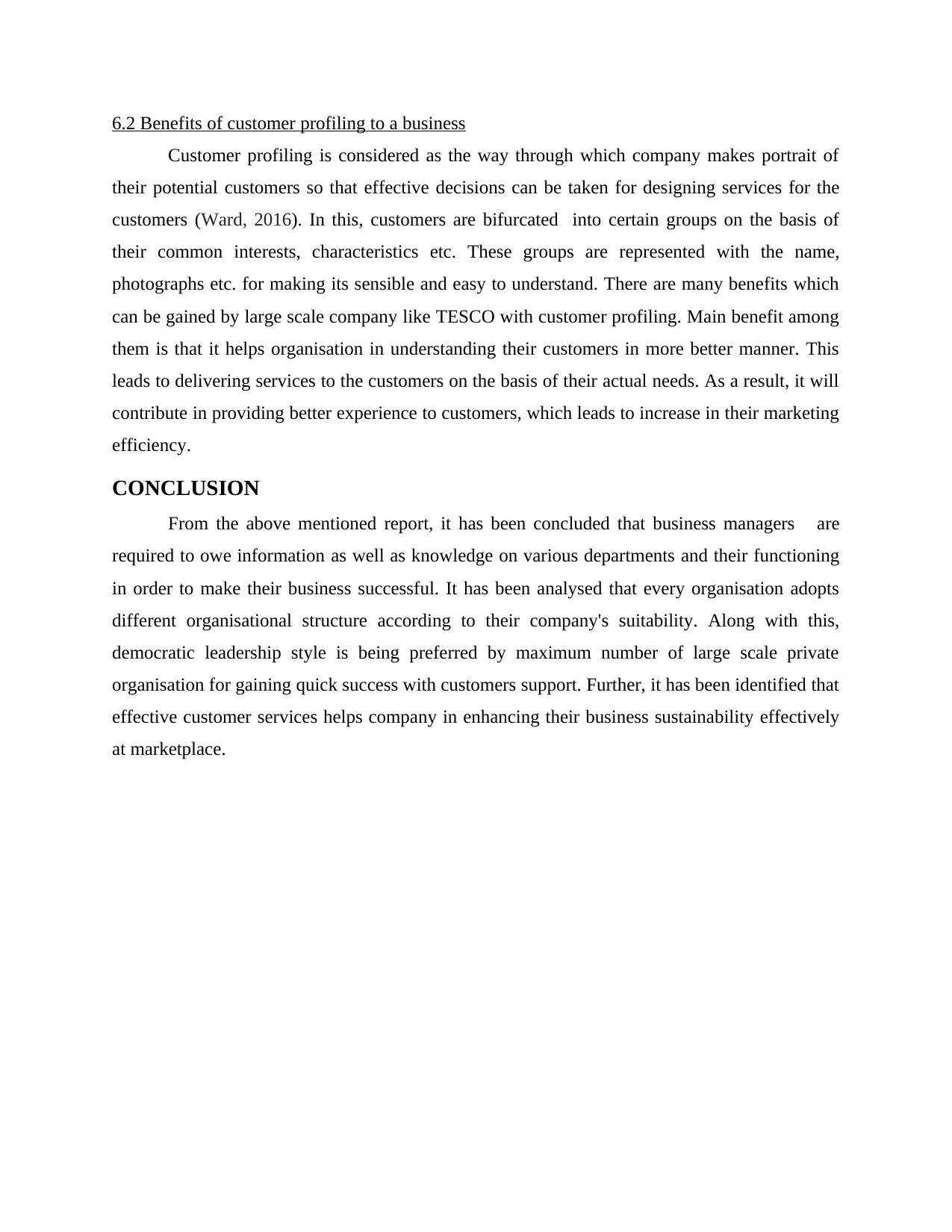
6.2 Benefits of customer profiling to a business
Customer profiling is considered as the way through which company makes portrait of
their potential customers so that effective decisions can be taken for designing services for the
customers (Ward, 2016). In this, customers are bifurcated into certain groups on the basis of
their common interests, characteristics etc. These groups are represented with the name,
photographs etc. for making its sensible and easy to understand. There are many benefits which
can be gained by large scale company like TESCO with customer profiling. Main benefit among
them is that it helps organisation in understanding their customers in more better manner. This
leads to delivering services to the customers on the basis of their actual needs. As a result, it will
contribute in providing better experience to customers, which leads to increase in their marketing
efficiency.
CONCLUSION
From the above mentioned report, it has been concluded that business managers are
required to owe information as well as knowledge on various departments and their functioning
in order to make their business successful. It has been analysed that every organisation adopts
different organisational structure according to their company's suitability. Along with this,
democratic leadership style is being preferred by maximum number of large scale private
organisation for gaining quick success with customers support. Further, it has been identified that
effective customer services helps company in enhancing their business sustainability effectively
at marketplace.
Customer profiling is considered as the way through which company makes portrait of
their potential customers so that effective decisions can be taken for designing services for the
customers (Ward, 2016). In this, customers are bifurcated into certain groups on the basis of
their common interests, characteristics etc. These groups are represented with the name,
photographs etc. for making its sensible and easy to understand. There are many benefits which
can be gained by large scale company like TESCO with customer profiling. Main benefit among
them is that it helps organisation in understanding their customers in more better manner. This
leads to delivering services to the customers on the basis of their actual needs. As a result, it will
contribute in providing better experience to customers, which leads to increase in their marketing
efficiency.
CONCLUSION
From the above mentioned report, it has been concluded that business managers are
required to owe information as well as knowledge on various departments and their functioning
in order to make their business successful. It has been analysed that every organisation adopts
different organisational structure according to their company's suitability. Along with this,
democratic leadership style is being preferred by maximum number of large scale private
organisation for gaining quick success with customers support. Further, it has been identified that
effective customer services helps company in enhancing their business sustainability effectively
at marketplace.
⊘ This is a preview!⊘
Do you want full access?
Subscribe today to unlock all pages.

Trusted by 1+ million students worldwide
1 out of 14
Related Documents
Your All-in-One AI-Powered Toolkit for Academic Success.
+13062052269
info@desklib.com
Available 24*7 on WhatsApp / Email
![[object Object]](/_next/static/media/star-bottom.7253800d.svg)
Unlock your academic potential
Copyright © 2020–2025 A2Z Services. All Rights Reserved. Developed and managed by ZUCOL.





